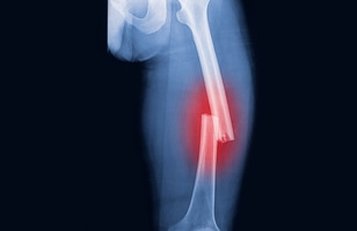Increased Fracture Risk: Seniors Not Taking Vitamin D Supplements

03/2017
Despite national recommendations for daily vitamin D intake, less than 50% of patients reported consistently taking vitamin D supplements after a hip fracture, a known treatment and preventive strategy for osteoporosis, ac-cording to a study presented today at the 2017 annual meeting of the American Academy of Orthopaedic Surgeons (AAOS), in San Diego (abstract 037).
In the United States, an estimated 44 million people have osteoporosis, and another 10 million are at risk for the disease, which causes progressive bone loss and increased fracture risk. One in two women and one in four men older than 50 years of age will sustain a bone fracture caused by osteoporosis. These potentially debilitating injuries include fractures of the hip, spine, wrist, arm or leg, often occurring from a fall.
A bone fracture often is the first sign of the disease, which develops slowly with no other symptoms. Medication, weight-bearing exercise, and/or vitamin D, calcium or estrogen supplements can prevent subsequent fractures.
The U.S. Food and Nutrition Board of the Health and Medicine Division of the National Academies of Sciences, Engineering, and Medicine recommends 600 IU of vitamin D each day for adults, and 800 IU for Americans aged 71 years and older.
In this study, Canadian researchers interviewed 573 hip fracture patients about their vitamin D intake during physician visits for two years after hip fracture surgery. The mean patient age was 74.1 and most (66.3%) were women. They found that 45.7% of the patients consistently took vitamin D supplements as recommended, 35.6% took supplements inconsistently, and less than 19% took no supplements. Despite well-developed guidelines and close follow-up in a clinical trial, a low proportion of elderly patients with hip fracture are consistently taking vitamin D. This suggested a need to develop and evaluate additional strategies to promote compliance, according to Mohit Bhandari, MD, an orthopedic surgeon and the research chair of musculoskeletal trauma and surgical outcomes, McMaster University, in Hamilton, Ontario.
“Vitamin D supplementation following hip fracture surgery is grossly underprescribed,” Dr. Bhandari said. “Giv-en its potential to improve patient function independent of other therapies, it seems improved advocacy and educa-tion—aimed at doctors and patients—about vitamin D supplementation is both worthwhile and evidence-based.”
It appeared that this cohort of elderly osteoporotic patients was unaware of or ignored the benefits, safety and ease of taking vitamin D supplements, according to co-researcher Earl Bogoch, MD, an orthopedic surgeon at the University of Toronto.
The AAOS position statement, “Orthopaedic Care of Patients With Fragility Fractures,” recommends that U.S. health care providers proactively screen, monitor and, if necessary, assist in getting treatment for elderly and other at-risk patients for osteoporosis after an initial bone fracture to prevent subsequent fractures.
http://www.pharmacypracticenews.com/Clinical/Article/03-17/Increased-Fracture-Risk-Seniors-Not-Taking-Vitamin-D-Supplements/40702
Despite national recommendations for daily vitamin D intake, less than 50% of patients reported consistently taking vitamin D supplements after a hip fracture, a known treatment and preventive strategy for osteoporosis, ac-cording to a study presented today at the 2017 annual meeting of the American Academy of Orthopaedic Surgeons (AAOS), in San Diego (abstract 037).
In the United States, an estimated 44 million people have osteoporosis, and another 10 million are at risk for the disease, which causes progressive bone loss and increased fracture risk. One in two women and one in four men older than 50 years of age will sustain a bone fracture caused by osteoporosis. These potentially debilitating injuries include fractures of the hip, spine, wrist, arm or leg, often occurring from a fall.
A bone fracture often is the first sign of the disease, which develops slowly with no other symptoms. Medication, weight-bearing exercise, and/or vitamin D, calcium or estrogen supplements can prevent subsequent fractures.
The U.S. Food and Nutrition Board of the Health and Medicine Division of the National Academies of Sciences, Engineering, and Medicine recommends 600 IU of vitamin D each day for adults, and 800 IU for Americans aged 71 years and older.
In this study, Canadian researchers interviewed 573 hip fracture patients about their vitamin D intake during physician visits for two years after hip fracture surgery. The mean patient age was 74.1 and most (66.3%) were women. They found that 45.7% of the patients consistently took vitamin D supplements as recommended, 35.6% took supplements inconsistently, and less than 19% took no supplements. Despite well-developed guidelines and close follow-up in a clinical trial, a low proportion of elderly patients with hip fracture are consistently taking vitamin D. This suggested a need to develop and evaluate additional strategies to promote compliance, according to Mohit Bhandari, MD, an orthopedic surgeon and the research chair of musculoskeletal trauma and surgical outcomes, McMaster University, in Hamilton, Ontario.
“Vitamin D supplementation following hip fracture surgery is grossly underprescribed,” Dr. Bhandari said. “Giv-en its potential to improve patient function independent of other therapies, it seems improved advocacy and educa-tion—aimed at doctors and patients—about vitamin D supplementation is both worthwhile and evidence-based.”
It appeared that this cohort of elderly osteoporotic patients was unaware of or ignored the benefits, safety and ease of taking vitamin D supplements, according to co-researcher Earl Bogoch, MD, an orthopedic surgeon at the University of Toronto.
The AAOS position statement, “Orthopaedic Care of Patients With Fragility Fractures,” recommends that U.S. health care providers proactively screen, monitor and, if necessary, assist in getting treatment for elderly and other at-risk patients for osteoporosis after an initial bone fracture to prevent subsequent fractures.
http://www.pharmacypracticenews.com/Clinical/Article/03-17/Increased-Fracture-Risk-Seniors-Not-Taking-Vitamin-D-Supplements/40702
